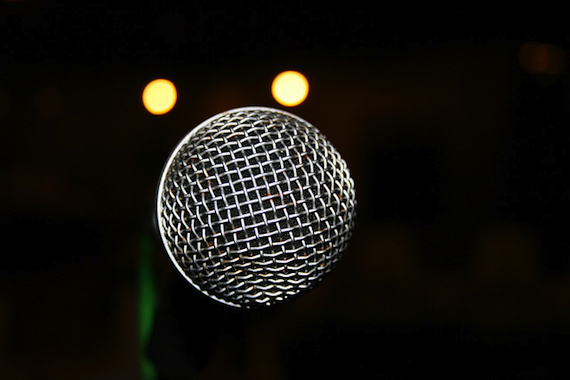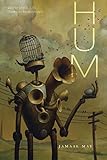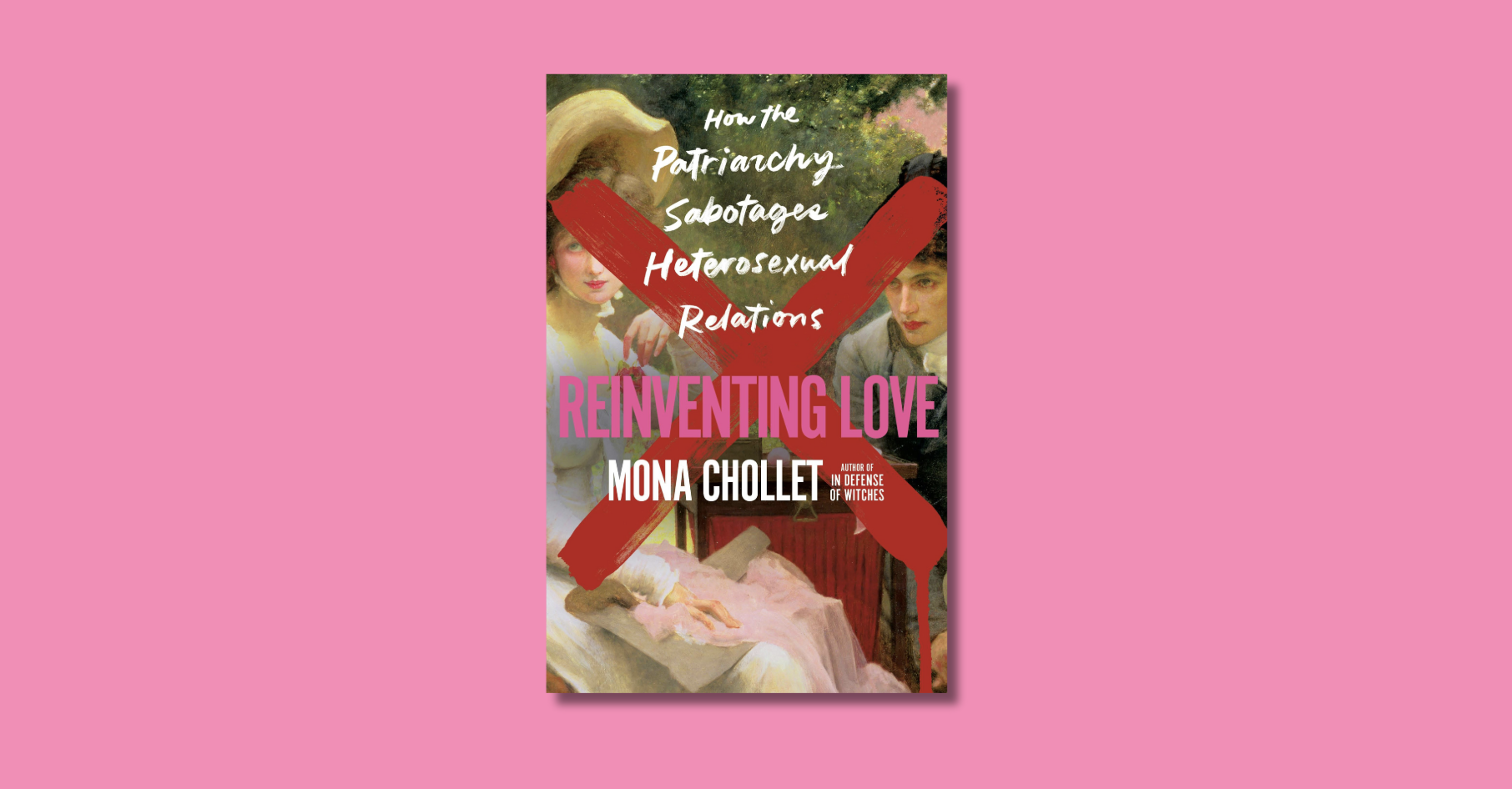
American poetry has performance issues. If you go to a lot of poetry readings, you know well the feeling I’m about to describe: you’re feeling good, beer and/ or notebook in hand, when a poet, acclaimed or with just a handful of poems in the world, takes the stage. As the poet approaches the mic, you brace yourself: this could go one of two ways. The poet’s voice could embrace you warmly, like that of a singer, or you could spend the next hour listening to a drone with a slight uptick at the end of each line. The poet could make conversational eye contact with the audience, as poets Naomi Shihab Nye, Forrest Gander, and Toi Derricotte do; or she could never look up from the podium.
Why do some poets perform as though they had just come to in a bad dream? Sometimes, because they are amateurs, high school or new MFA students; but just as often, standoffishness about performance comes from experienced writers whose work glows on the page, but whose words just can’t seem to survive the trip from Garamond to the tip of the poet’s tongue.
Meanwhile, the other American poetry – the stage-centered continuum that runs from slam to rap and back again – whose lifeblood is making poems sound and feel good out loud, has taken a long time to get a break. In 2000 in the Paris Review, Harold Bloom provided what seemed to be the official “establishment” (some would say “old white dude”) verdict on slam poetry: “I can’t bear these accounts I hear…of these poetry slams, in which various young men and women in various late-night spots are declaiming rant and nonsense at each other…This isn’t even silly; it is the death of art.”
Okay, Harold. But it’s been almost thirty years since the first slam was organized in a working-class pub in Chicago, and since Miguel Algarín made poetry-out-loud one of the pillars of the Nuyorican Poets Café. Slam has now been part of the nation’s poetry vocabulary for long enough to deserve to move out of its parents’ basement and pay its own rent. It’s made publishing careers and recording contracts, and even Broadway stars. Saul Williams, arguably the biggest star of slam’s first generation, is now playing a Tupac Shakur-inspired character on Broadway in “Holler if Ya Hear Me.” The choice of Williams for the role draws a direct line between slam and rap, the closest the average American gets to poetry by turning on the radio.
But perhaps most importantly, slam’s near-middle-age means that many young poets – including some now rising to poetry’s version of rock-star status – have grown up in it. Poets who cut their teeth on slam make up the ranks of some of America’s finest emerging and mid-career poets, and have won not only national slam accolades but hallmarks of success associated with poetry print culture: admission to top MFA programs, book publication from leading small presses, the Ruth Lilly Poetry Fellowship, the Whiting Award, and more.
 As these poets have developed a new kind of poetry career, where a packed performance tour can predate a first-book publication by years, the line Bloom so firmly drew in the sand has been eroding. Other, less hidebound critics have taken note: Dana Gioia, in his 2004 essay “Disappearing Ink: Poetry at the End of Print Culture,” saw that slam and spoken word were inspiring a new poetry audience, one that circumvented the academy and New York publishing houses. Susan Somers Willett, in The Cultural Politics of Slam Poetry, notes that slam has, since its inception, put critical power directly into the hands of the audience, making slam attendees feel that they, not the editors of book reviews, are cultural tastemakers and determiners of authenticity. As poets with performance backgrounds rise through the ranks of poetry print culture, American poetry appears caught between a fear of performance and a celebration of it. As these page + stage poets become more prominent in universities, journals, and reading series, are they helping to renew conversations about performance as an aspect of making poems?
As these poets have developed a new kind of poetry career, where a packed performance tour can predate a first-book publication by years, the line Bloom so firmly drew in the sand has been eroding. Other, less hidebound critics have taken note: Dana Gioia, in his 2004 essay “Disappearing Ink: Poetry at the End of Print Culture,” saw that slam and spoken word were inspiring a new poetry audience, one that circumvented the academy and New York publishing houses. Susan Somers Willett, in The Cultural Politics of Slam Poetry, notes that slam has, since its inception, put critical power directly into the hands of the audience, making slam attendees feel that they, not the editors of book reviews, are cultural tastemakers and determiners of authenticity. As poets with performance backgrounds rise through the ranks of poetry print culture, American poetry appears caught between a fear of performance and a celebration of it. As these page + stage poets become more prominent in universities, journals, and reading series, are they helping to renew conversations about performance as an aspect of making poems?
 The thing about the page, as we’ve known since Gutenberg, is that it reaches more people, even if “more” is only a couple thousand. Or in the words of Aaron Samuels, himself a young poet who straddles the worlds of performance and print, “the great thing about print is that you don’t have to be there.” But despite that reach, poetry readings have been essential to building poets’ readerships since the fifties. To disdain them is to shoot yourself in the foot. Jamaal May, a Detroit poet with deep roots in the slam scene there, is among those who have started the campaign to make “page” poets better performers. Before the publication of his first book, Hum, he wrote a blog post for Poets & Writers called “On Giving a Not Terrible Reading.” “Writers tell me they don’t want to perform or be seen as performative,” he writes, but “I would argue that an overly dry, disengaged reading is in fact a performance. No one speaks that way.” With this criticism, May hit on the irony that underlies so many tepid readings by “page” poets: poets may fear that an engaged, even dramatic performance may come off as inauthentic; but as with wooden acting, not allowing the poem’s elements to guide a reading of it can seem far more false than reading with passion.
The thing about the page, as we’ve known since Gutenberg, is that it reaches more people, even if “more” is only a couple thousand. Or in the words of Aaron Samuels, himself a young poet who straddles the worlds of performance and print, “the great thing about print is that you don’t have to be there.” But despite that reach, poetry readings have been essential to building poets’ readerships since the fifties. To disdain them is to shoot yourself in the foot. Jamaal May, a Detroit poet with deep roots in the slam scene there, is among those who have started the campaign to make “page” poets better performers. Before the publication of his first book, Hum, he wrote a blog post for Poets & Writers called “On Giving a Not Terrible Reading.” “Writers tell me they don’t want to perform or be seen as performative,” he writes, but “I would argue that an overly dry, disengaged reading is in fact a performance. No one speaks that way.” With this criticism, May hit on the irony that underlies so many tepid readings by “page” poets: poets may fear that an engaged, even dramatic performance may come off as inauthentic; but as with wooden acting, not allowing the poem’s elements to guide a reading of it can seem far more false than reading with passion.
Slam poets have typically not shied away from associations with the theatrical, maybe because slam is more likely to embrace genres, like persona, that lend themselves to character-building. Airea Matthews, a graduate of the Helen Zell Writers’ Program at the University of Michigan and a two-time finalist in the Women of the World poetry slam, is often drawn to persona in both her performance work and her work on the page. Persona and the drama it engenders on paper or on stage, she believes, is mostly about empathy, including “the grand acknowledgment of all you don’t and can’t know.” It’s hard to accuse performance with that sentiment at its core of being false.
Susan Somers-Willett suggests that some poets’ fear of inauthenticity may stem in part from white poets and audiences seeing blackness as the most authentic expression of identity. Somers-Willett tracks white poets’ consumption and imitation of black art from minstrelsy to the Beats. These movements, she writes, provide a precedent for the audiences at poetry slams, who are predominantly white while the winners of major slam competitions are predominantly black. Because many slam poets deal directly with themes of social injustice, “…the slam may serve as a rare opportunity for liberal, white, middle-class audiences to legitimately support poets of color who critique white positions of privilege.” Poets who feel their privilege sharply may balk at the use of performance elements they associate with such critiques.
 Is the opposite true – do poets who came up in performance communities shy away from line and form? There are certainly slam poets who disdain print, but the poets I spoke to for this article – all of them with successful print ventures as well as long experience in and love for slam – said that a poem’s “page” elements are just as important as aspects of performance. For some, performance came first, but that doesn’t mean that performance is an end for every poem. Aaron Samuels, whose first book Yarmulkes and Fitted Caps came out last fall, says that when he sits down to write, “I often don’t know what the best way is for a poem to reach the world. And I think it’s important for me not to know that.” Poets who don’t make use of performance, he suggests, may not feel comfortable with what the experience of being on stage has to offer. “When you’re a high school English student, you know that alliteration is an option,” Samuels offers. “If you grow up with a performance background, you know that that’s something you can do.”
Is the opposite true – do poets who came up in performance communities shy away from line and form? There are certainly slam poets who disdain print, but the poets I spoke to for this article – all of them with successful print ventures as well as long experience in and love for slam – said that a poem’s “page” elements are just as important as aspects of performance. For some, performance came first, but that doesn’t mean that performance is an end for every poem. Aaron Samuels, whose first book Yarmulkes and Fitted Caps came out last fall, says that when he sits down to write, “I often don’t know what the best way is for a poem to reach the world. And I think it’s important for me not to know that.” Poets who don’t make use of performance, he suggests, may not feel comfortable with what the experience of being on stage has to offer. “When you’re a high school English student, you know that alliteration is an option,” Samuels offers. “If you grow up with a performance background, you know that that’s something you can do.”
Poets with May’s, Samuels’s, and Matthews’s backgrounds are positioning themselves as bridges between “the two cultures” of American poetry. But don’t call them “crossovers” – rather than leaving performance behind, they are helping to build a poetry audience that craves both excellence on the page and a vibrant performance behind the mic. “Page Meets Stage,” a Manhattan reading series run by slam poet Taylor Mali pairs Pulitzer Prize winners with National Slam champions. The series’ success suggests that the audience is there: slam and “literary” listeners alike want to celebrate, and even blend, both traditions, rather than rank one above the other.
And poets comfortable with both are aware of the potential for groundbreaking work. While promoting Hum, Jamaal May made a poetry video of himself reading/reciting his poem “I Do Have a Seam.” The poem is a contrapuntal, which means it appears in two columns and can be read three ways: the first column alone, the second alone, or by connecting the two. In between the two columns, naturally, is a seam of space. The video opens with a shot of the left column, folded along its seam, black ink on white paper. Later, we see its right half, white ink on black. By lingering on the text, May calls attention to the form of the poem as it can only be seen on the page, with all three performance possibilities presented simultaneously to the reader. But he also makes his performance of the work essential, moving a hand across his mouth, closing his eyes. At one point, he quietly doubles his voice. What kind of poet does May want to be? Steeped in the familial community of Detroit slam, May is now finding the kind of success most poets in MFA programs dream of: university and writing conference fellowships, major literary prizes. But the video for “I Do Have a Seam,” tellingly, doesn’t choose sides. Instead, in keeping with many stage + page poets’ philosophies of composition, May’s work insists on being the thread that binds performance, with its potential for heightened sonic and dramatic effects, and the quieter, more visual work of the page.
Is this inter-weaving of genres, this promising poetry Frankenstein, actually changing the way students and teachers approach poetry and its performance? The litmus test, as usual, is high school and undergraduate students. Keith Taylor, director of the undergraduate creative writing program at the University of Michigan, has watched both slam and “literary” poetry rise and fall in popularity. Once, he recalls, young poets talked of “Page vs. Stage,” clearly privileging “page” as the more serious. Now, he says, “it is clearly Stage AND Page. And some of them are making it clear that you can have your cake and eat it too… They are also imagining their poems as different things – poems for performance and poems for print. Two very different kinds of composition.” But fervent supporters of performance, Taylor says, can sometimes alienate the young writers who come to poetry more quietly and bookishly. If beginning writers start to perceive poetry as being only for performance, Taylor fears, this will scare off some great talent.
But if we’re lucky, poets like May, Samuels, Matthews, and others will continue to help both slam communities and university writing programs occupy that middle space – that seam, that delicious gutter where poets use not just our voices or our hands, but all of our tools. When their work is done, I can’t say there will be no more terrible readings; but there might be a great many better ones.
Image via sanfinix/Flickr








